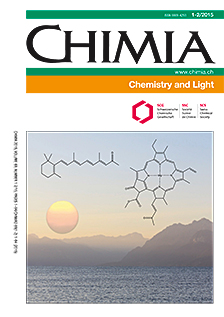Fe vs. TiO2 Photo-assisted Processes for Enhancing the Solar Inactivation of Bacteria in Water
DOI:
https://doi.org/10.2533/chimia.2015.7Keywords:
Bacteria inactivation, Neutral photo-fenton, Solar disinfection, Tio2 photo-catalysisAbstract
Batch solar water disinfection (SODIS) is a known, simple and low-cost water treatment technology. SODIS is based on the synergistic action of temperature increase and light-assisted generation of Reactive Oxygen Species (ROS) on bacteria. ROS are generated via the action of solar photons on i) Natural Organic Matter (NOM), ii) some mineral components of water (Fe oxides or Fe-organic complexes, nitrogen compounds) and iii) endogenous bacteria photosensitizers (e.g. cytochrome). SODIS has proven its effectiveness for remote settlements or urban slums in regions with high incident solar radiation. All of the internal and external simultaneous processes are often driven by photoactive Fe-species present in the cell, as well as in the natural water sources. In SODIS, a temperature of 50 °C is required and due to this temperature dependence, only 1–2 L can be treated at a time. As required exposure time strongly depends on irradiation intensity and temperature, some SODIS households could be overburdened, leading to inadequate treatment and probable bacterial re-growth. This is why TiO2 photocatalysis and Fe photo-assisted systems (i.e. photo-Fenton reactants) have been considered to enhance the photo-catalytic processes already present in natural water sources when exposed to solar light. Both TiO2 and Fe-photoassisted processes, when applied to water disinfection aim to improve the performance of solar bacteria inactivation systems by i) enhancing ROS production, ii) making the process independent from the rise in temperature and as a consequence iii) allowing the treatment of larger volumes than 1–2 L of water and iv) prevent bacterial (re)growth, sometimes observed after sole solar treatment.Downloads
Published
2015-02-25
Issue
Section
Scientific Articles
License
Copyright (c) 2015 Swiss Chemical Society

This work is licensed under a Creative Commons Attribution-NonCommercial 4.0 International License.
How to Cite
[1]
C. Pulgarin, Chimia 2015, 69, 7, DOI: 10.2533/chimia.2015.7.







